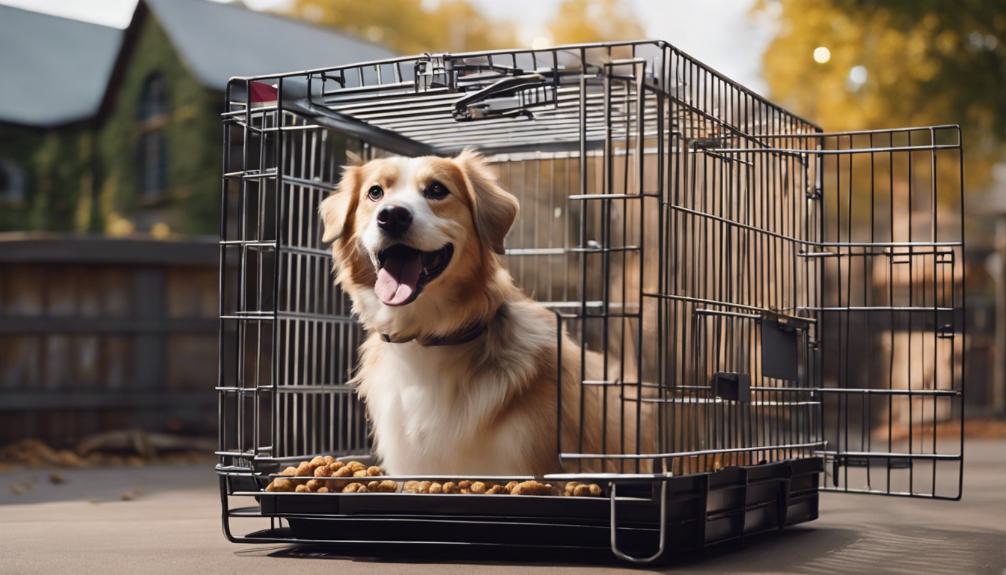How to Crate Train a Senior Dog? Comfortable Crate Tips
To train a senior dog to use a crate, begin by selecting a crate with enough space for them to stand, turn, and lie down comfortably. Make it inviting with a plush bed, water, and their favorite toy. Use delicious treats and praise to motivate them to enter willingly. Gradually close the door, rewarding them for staying calm. Increase the time spent in the crate slowly, providing breaks for bathroom trips and playtime. If your senior dog whimpers or barks, address the behavior calmly. Remember, patience and consistency are essential. Following these steps will help your senior dog feel safe and secure in their crate. You can do it!
Selecting the Right Crate
When selecting a crate for your senior dog, choose one that allows them to stand, turn around, and lie down with ease. If your dog has joint issues, a larger crate with added padding can provide extra comfort. Consider the crate’s material—options include plastic, fabric, wire, or mesh—based on what best suits your senior dog’s needs.
Make the crate comfortable by adding a cozy bed, fresh water, and their favorite toy. Place the crate in a part of your home that’s quiet yet not completely isolated, helping your dog feel part of the family without being overwhelmed by noise.
When selecting a crate, keep in mind the various materials available. Plastic crates are lightweight and easy to clean, making them a practical option for many. Fabric crates are portable and soft, but not suitable if your dog likes to chew. Wire crates offer excellent ventilation and adjustable partitions for growing dogs, while mesh crates are great for travel due to their collapsible, lightweight design.
Creating a Cozy Den Space
To create a comfortable den for your senior dog, equip the crate with a soft bed or blanket. If your dog has joint issues, choose a well-padded crate.
Add items like their favorite toys or a familiar blanket to increase comfort. Consider placing calming pheromones near the crate to aid in relaxation.
Ensure the crate is large enough for your dog to easily move and stretch.
Introducing Treats and Praise

Use small, tasty treats like cooked chicken or freeze-dried liver to encourage your senior dog to enter the crate willingly. These treats are considered high-value because dogs find them especially appealing.
Offer calm, positive praise every time your senior dog goes into the crate on their own. This reinforces good behavior and makes the crate a pleasant place for them.
Consistently use both treats and praise to help your dog associate the crate with positive experiences. This method is effective in training dogs of all ages, including seniors, to feel comfortable and secure in their crates.
Gradual Door Closure Training
To help your senior dog feel comfortable with crate training, begin by closing the crate door for brief periods, such as 1-2 minutes. This approach helps prevent anxiety. As your dog becomes more accustomed to the crate, gradually extend the duration the door remains shut.
To aid relaxation, offer your dog favorite toys or treats inside the crate. Observe your dog’s reactions carefully and provide positive feedback when they remain calm. Consistency is crucial in effectively crate training your senior dog using this method.
Give these practices time to work, adjusting as needed based on your dog’s response. This methodical increase in crate time allows your senior dog to adapt without stress, improving the likelihood of successful crate training.
Extending Crate Time Slowly

To extend the time your senior dog spends in a crate, take slow, measured steps to maintain their comfort and relaxation.
- Monitor your dog’s behavior and comfort level: Keep a close eye on how your dog acts during increased crate time. Signs of stress might include excessive panting, whining, or restlessness.
- Use calming aids: Items like interactive toys or soothing music can help keep your dog calm and engaged while crated. For example, a puzzle toy with treats can keep them occupied, and classical music has been shown to reduce stress in dogs.
- Provide regular breaks: Allow your dog to take potty breaks and stretch periodically. This helps meet their physical needs and prevents discomfort.
Adjust the duration of crate sessions based on your dog’s reactions. Build up the time gradually to help your dog adapt without stress.
Addressing Whining or Barking
To address whining or barking in a senior dog during crate training, first pinpoint the root cause, such as anxiety or discomfort. Employ positive reinforcement to reward your dog when they remain calm and ignore behaviors meant to seek attention. Ensure the crate is comfortable and welcoming to discourage any whining or barking.
If the problem continues, consult with a professional dog trainer. Gradually increasing the time your dog spends in the crate can also help them adjust better.
Overcoming Negative Past Experiences

To assist older dogs in overcoming their negative past experiences with crates, it’s essential to reintroduce the crate gradually and with positive reinforcement. Here’s how you can do it effectively:
- Identify Triggers: Determine what specific aspects of the crate experience previously upset your dog. This could be the sight of the crate, being enclosed, or even the location of the crate in your home.
- Use High-Value Treats: Incorporate treats that your dog finds irresistible to build positive associations with the crate. For example, you might use pieces of chicken, cheese, or special dog treats that are only given during crate time.
- Implement Desensitization Techniques: Gradually expose your dog to the crate in a non-threatening manner. Begin by placing the crate in a common area with the door open, allowing your dog to explore at their own pace. Gradually increase the time your dog spends near or in the crate, always ensuring it’s a positive experience.
Troubleshooting Unsuccessful Training
If you encounter difficulties in crate training your senior dog, reassess your training strategy to identify where improvements can be made. Consider the physical limitations of your senior dog and adjust the training methods to be more suitable. For example, a dog with arthritis might need a softer bed inside the crate. Address any negative associations your dog may have developed with the crate. This can involve changing the location of the crate or ensuring it’s a peaceful area away from noise.
Modify the crate setup to help with any cognitive changes in your aging dog. This might mean placing familiar scents or toys inside. Use positive reinforcement techniques that cater to your older dog’s capabilities, such as offering treats for entering the crate or spending short periods inside it.
Seek assistance from a professional trainer or behavior consultant if the problems persist. They can provide specialized guidance tailored to your dog’s specific needs.
Frequently Asked Questions
Can Older Dogs Be Crate Trained?
Yes, older dogs can be crate trained. With patience and empathy towards their unique needs, you can create a safe and comfortable space for them to relax. Positive reinforcement will help them adjust gradually.
Is It OK to Crate a Senior Dog at Night?
Yes, it’s acceptable to crate a senior dog at night. Make sure the setup is comfy and safe. Watch for signs of restlessness or anxiety. Adjust training as needed. Your senior pup may benefit from a cozy crate routine.
How Do I Get My Older Dog to Sleep in His Crate?
Encourage your older dog to sleep in the crate by making it cozy with a soft blanket and using treats for positive reinforcement. Gradually increase crate time at night in a quiet area for better sleep.
How Long Does It Take to Crate Train a 2 Year Old Dog?
Crate training your 2-year-old dog can take a few weeks to a few months, depending on their temperament. Stay consistent, use positive reinforcement, and be patient. Adjust training methods as needed and seek professional guidance for efficient results.
Conclusion
In conclusion, when crate training your senior dog, choose the right crate and aim for comfort. Start with a suitable crate and make it inviting with blankets and toys.
Introduce your dog to the crate slowly using treats and praise to build a positive association. Be patient and address any problems as they arise.
With consistent effort, your senior dog will grow to see their crate as a secure retreat. Keep the training steady and straightforward, and your dog will adapt in time.

